If you’ve ever sat down at a Mexican taquería, you’ve probably noticed bottles of Mexican hot sauce on every table. This authentic Mexican hot sauce recipe brings the same bold flavor home, smooth, thin, and tangy, it’s made for drizzling over tacos, grilled meat and breakfast dishes.
This guide shows you how to make both at home, with a simple non-fermented base method. You’ll see the difference between red and green, learn heat control, discover optional variations like avocado or orange, and get storage and canning tips. At the end, you’ll find two complete recipe cards ready to follow.
Why This Is the Best Restaurant-Style Mexican Hot Sauce for Tacos
What makes Mexican hot sauce different from salsa
Salsa is usually chunky, scooped with chips, or used as a topping. Mexican hot sauce, on the other hand, is smooth, pourable, and vinegar- or lime-forward. That acidity not only preserves the sauce for a few days but also balances the heat of the chiles. The texture is thin enough to drizzle across tacos so every bite gets flavor without overwhelming the dish.
Red vs green at a glance
| Style | Base | Typical Chiles | Flavor Profile | Best Use |
|---|---|---|---|---|
| Salsa roja (red) | Tomatoes | Chile de árbol, jalapeño, or serrano | Smoky, earthy, slightly tangy | Carne asada, al pastor, burritos |
| Salsa verde (green) | Tomatillos | Serrano or jalapeño | Bright, fresh, tangy | Fish tacos, chicken, eggs |
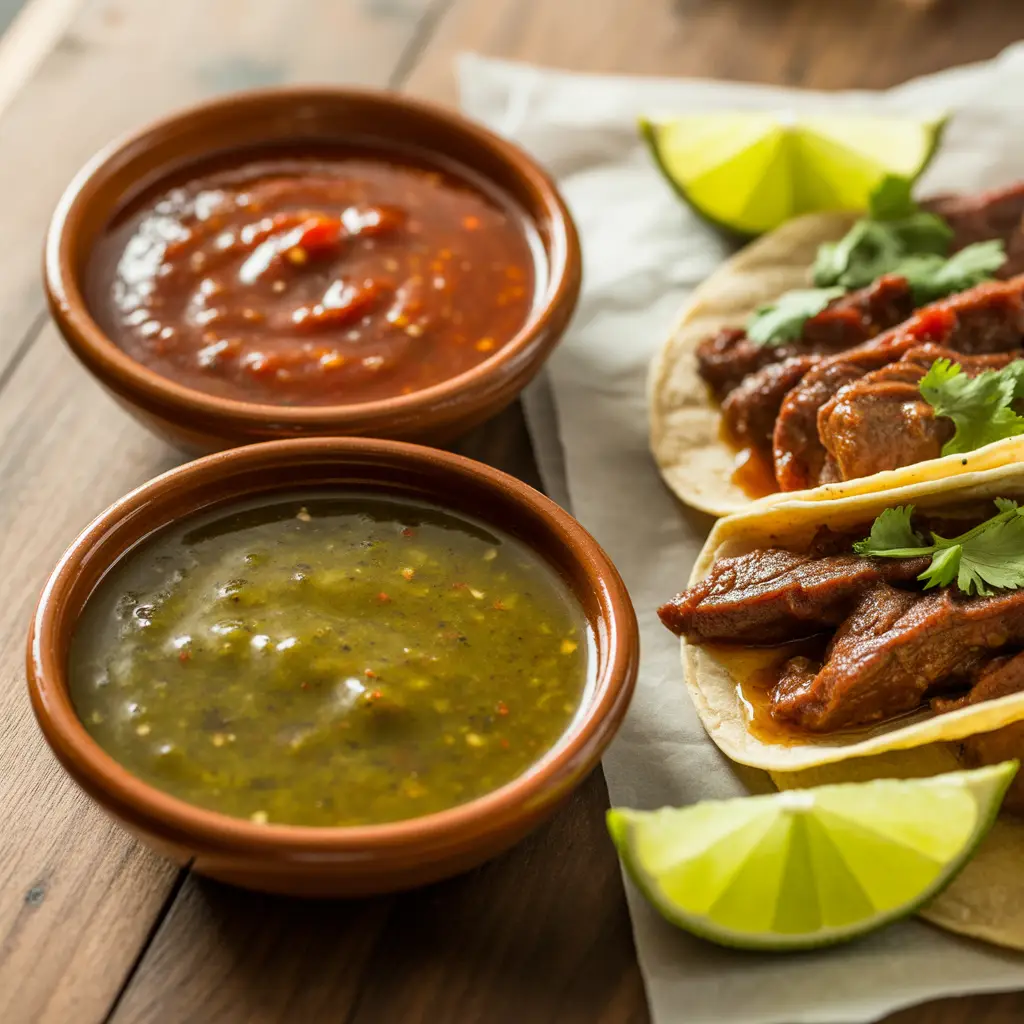
A Guide to the Chiles
When making a Mexican hot sauce recipe, the choice of chile defines the flavor, aroma, and heat level. Here’s a quick reference guide:
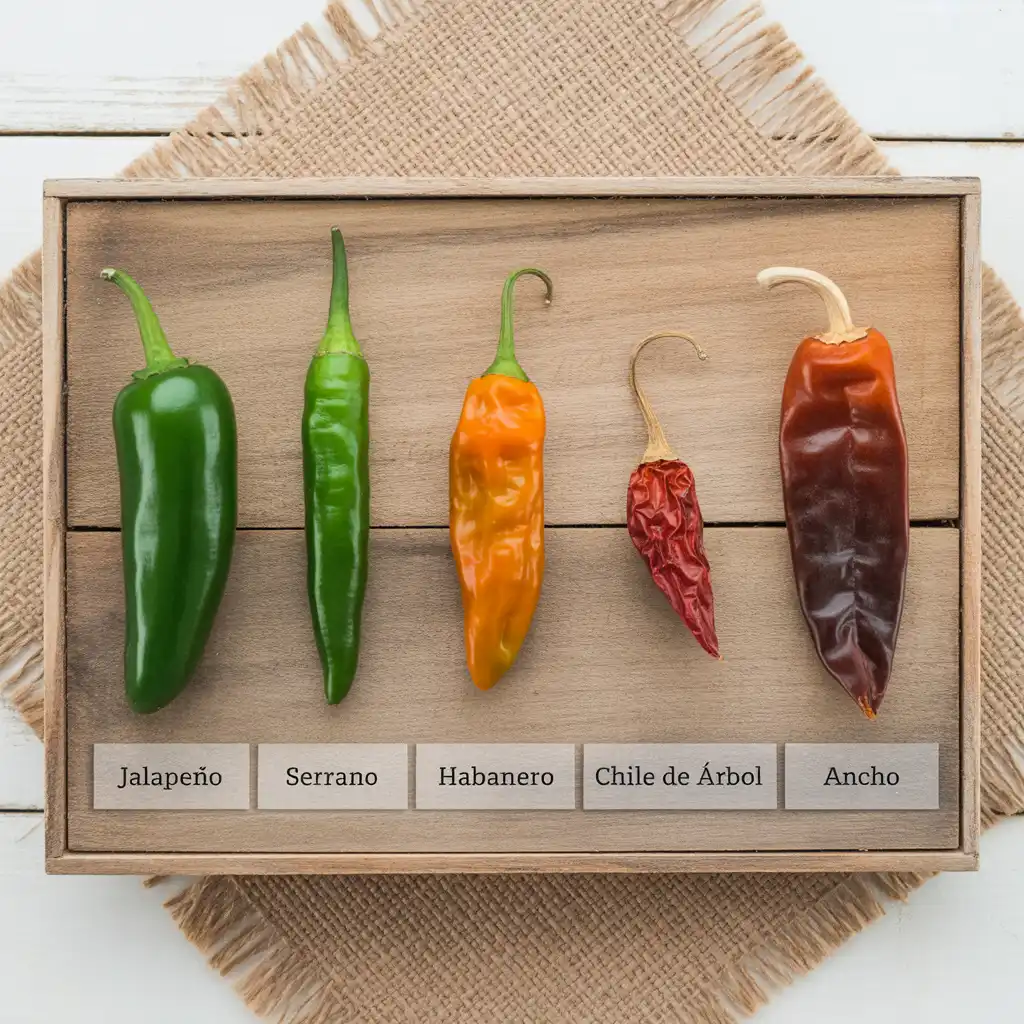
- Jalapeño (2,500–8,000 Scoville): Mild to medium heat, grassy, fresh flavor. Great for green sauces.
- Serrano (10,000–23,000 Scoville): Brighter, hotter than jalapeños, adds a crisp spice.
- Chile de Árbol (15,000–30,000 Scoville): Thin, fiery dried chile, slightly smoky and nutty. Perfect for salsa roja and taquera.
- Ancho (1,000–2,000 Scoville): Dried poblano, sweet, raisin-like flavor, more for depth than heat.
- Habanero (100,000–350,000 Scoville): Extremely hot, fruity, tropical aroma. Works well in habanero or orange hot sauces.
Ingredients You’ll Need (Red and Green Paths)
Red Mexican Hot Sauce Recipe (Salsa Roja)
The foundation of an authentic mexican hot sauce recipe is simple pantry ingredients:
- Tomatoes (ripe, medium)
- Chiles: dried chile de árbol for heat, or swap with jalapeño/serrano for milder options
- Onion & garlic (white onion works best)
- Fresh cilantro for brightness
- Acidity: vinegar or lime juice keeps the sauce fresh and thin
- Salt to balance flavors
- Optional: Mexican oregano or a pinch of cumin for extra depth
This mix creates the best mexican hot sauce recipe for tacos, grilled meats, and burritos.
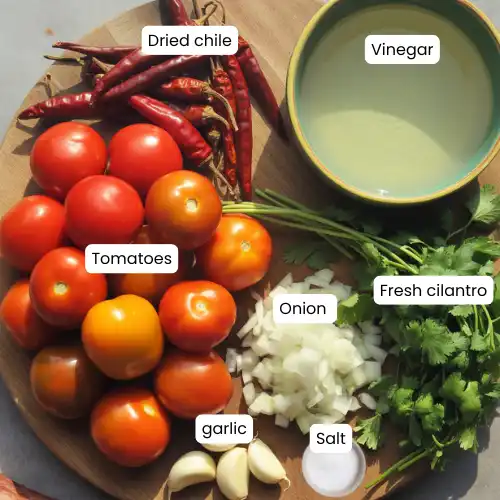
Green Mexican Hot Sauce Recipe (Salsa Verde)
The green version starts with tomatillos, a staple in Mexican cuisine often roasted to create tangy sauces, which bring brightness and acidity to the dish. You’ll need:
- Tomatillos (husked and rinsed)
- Chiles: serrano for heat, or jalapeño for a milder kick
- Onion & garlic
- Cilantro for freshness
- Lime juice for acidity
- Salt
- Optional: Sour cream or crema to make a creamy verde variation
Tomatillos are a staple in Mexican cuisine, often roasted for tangy sauces (Mexico In My Kitchen)
This mexican green hot sauce recipe is versatile and especially good on fish tacos, chicken, and huevos rancheros.
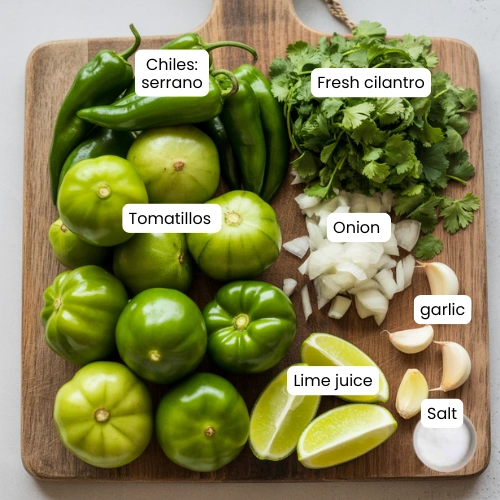
Heat and Flavor Tuning
One of the strengths of homemade mexican hot sauce recipes is flexibility. Here’s how to adjust:
- Milder: use jalapeño, remove seeds and membranes.
- Hotter: swap in serranos or add toasted árbol chiles.
- Flavor twists:
- Mexican avocado hot sauce recipe: blend in ripe avocado for guacamole salsa texture.
- Mexican orange hot sauce recipe: add fresh orange juice alongside lime for a citrusy kick.
- Mexican habanero hot sauce recipe: balance fiery habanero with mango or pineapple.
How to Make Mexican Hot Sauce (Non Fermented Base)
Roast vs boil methods
You can prepare the base two ways:
- Roast method: Char your tomatoes or tomatillos with onion and garlic under a broiler or in a dry skillet. Roasting gives depth, light smokiness, and caramelized sweetness, perfect for carne asada tacos.
- Boil method: Simmer produce in water until tender. Boiling creates a cleaner, fresher flavor, often used in taquería-style squeeze bottles.
Both methods work; it depends on whether you want bold and smoky (roast) or bright and tangy (boil).
Blend to a pourable restaurant texture
After cooking, add the produce to a blender along with salt and your choice of vinegar or lime. Blend until silky smooth. For true mexican restaurant hot sauce recipe results, adjust with extra water or vinegar until the sauce pours easily from a squeeze bottle.
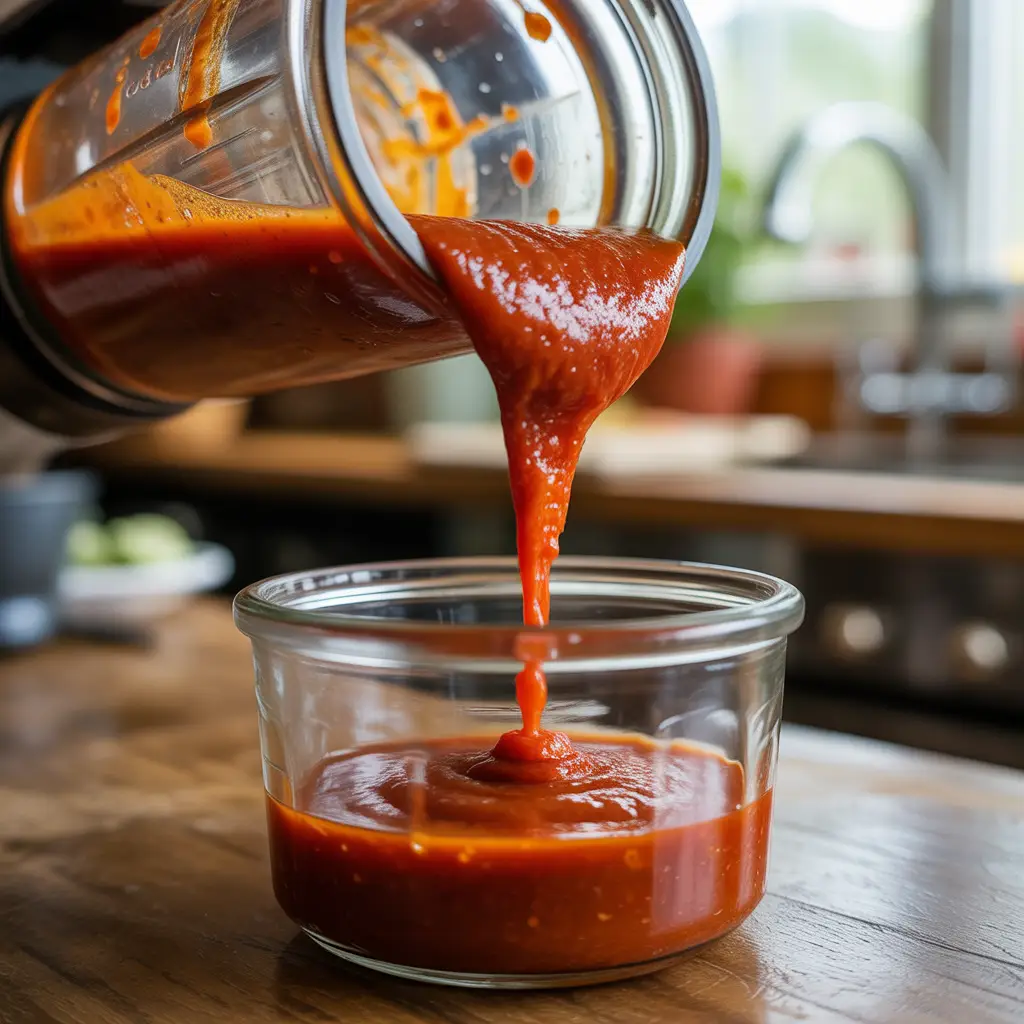
Season and bottle for tacos
Taste your sauce and adjust salt and acidity. If it feels too flat, add a splash more lime or vinegar. If it’s too strong, thin with a little cooking liquid. Funnel the sauce into clean squeeze bottles, cover, and refrigerate. Let it rest at least an hour before serving, the flavors will meld and sharpen.
Variations
Salsa Roja (Red Mexican Hot Sauce Recipe Tomato)
This classic mexican red hot sauce recipe uses tomatoes as the base. Pair them with chile de árbol or serrano for medium heat, or jalapeño for a milder kick. It’s smoky, tangy, and perfect for carne asada tacos or burritos.
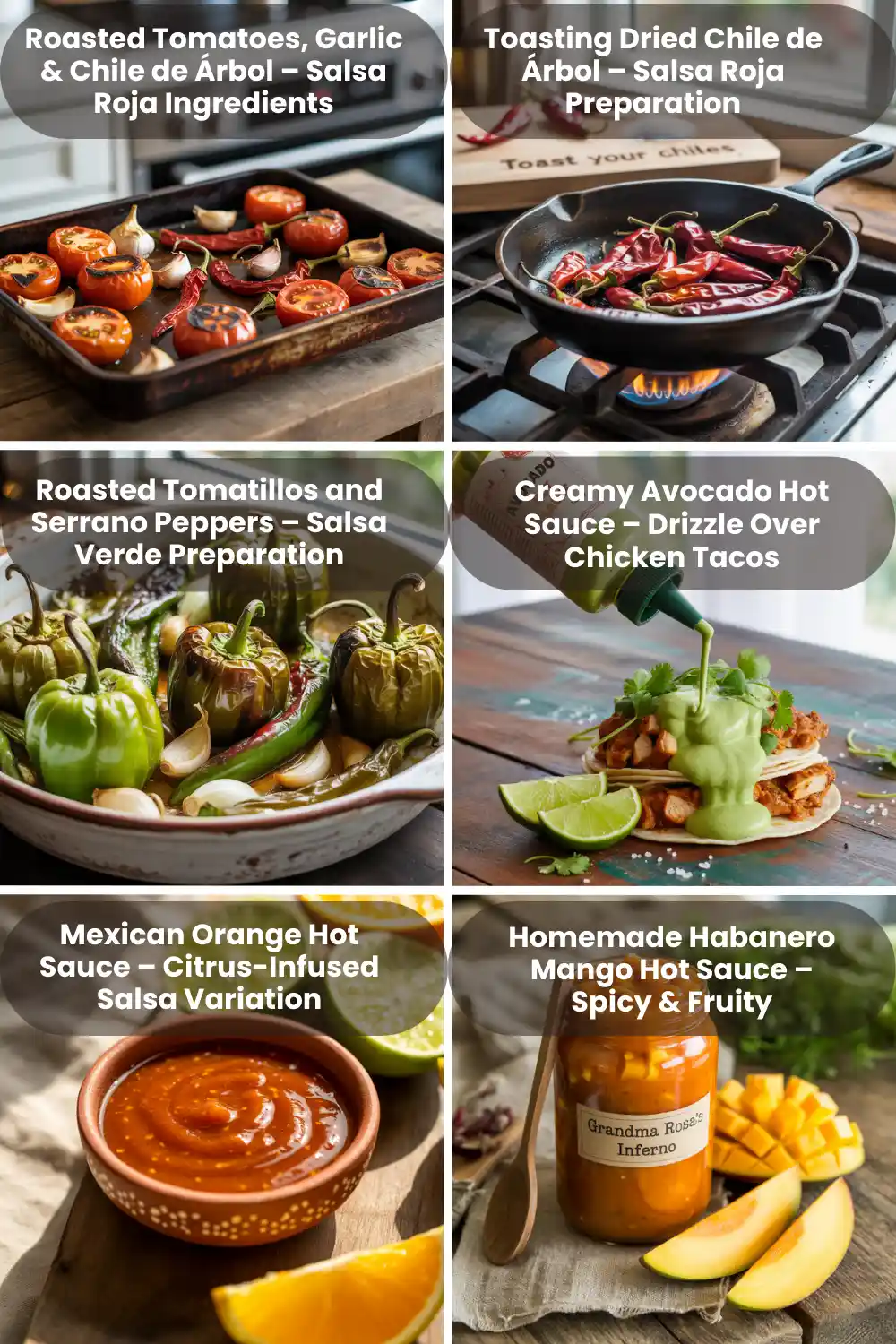
Mexican Hot Sauce Recipe Dried Peppers
For a deeper chile-forward flavor, toast dried chiles like árbol or guajillo in a dry skillet until fragrant. Rehydrate them in hot water, then blend into your sauce. This method is common in taquerías and gives a bold, restaurant-style kick.
Mexican Green Hot Sauce Recipe (Salsa Verde)
Made with tomatillos, serranos, garlic, and cilantro, this mexican hot sauce recipe green delivers a bright tang. Roast for a smoky edge or boil for a fresher profile. Ideal for chicken, fish tacos, and breakfast dishes.
Mexican Avocado Hot Sauce Recipe
Blend ripe avocado into salsa verde for a creamy, drizzle-able guacamole-style sauce. This variation is smooth, mild, and works great on tacos, burritos, and grain bowls.
Mexican Orange Hot Sauce Recipe
Adding fresh orange juice along with lime creates a tangy-sweet variation with zesty brightness. Perfect for fish tacos or grilled chicken.
Mexican Habanero Hot Sauce Recipe
For serious heat lovers, habaneros bring fruity fire. Balance the spice by adding mango or pineapple for sweetness. This spicy mexican hot sauce recipe is bold and pairs well with grilled shrimp or chicken.
Optional Fermented Mexican Hot Sauce Recipe
If you want a tangy probiotic twist, try fermenting chopped chiles, onion, and garlic in a salt brine for 2–5 days. Blend, then add vinegar for stability. Fermentation isn’t required for the classic non fermented hot sauce recipe, but it’s a fun variation.
Use Cases and Serving Ideas
Mexican Hot Sauce for Tacos
Nothing beats a drizzle of hot sauce over tacos. The mexican hot sauce recipe for tacos is thin, tangy, and designed to coat the filling without making tortillas soggy. Try salsa roja on al pastor or carne asada, and salsa verde on fish tacos, chicken, or vegetarian fillings.
Breakfast Favorites
Mexican hot sauce adds life to morning dishes:
- Huevos rancheros: spoon salsa roja over fried eggs and tortillas.
- Chilaquiles: toss tortilla chips with salsa verde, top with eggs and cheese.
- Breakfast burritos: a squeeze of roja or verde balances eggs, beans, and potatoes.
Bowls and Meal Prep
Add a spoonful to grain bowls, salads, or burrito bowls for an instant flavor upgrade. Verde works especially well with rice, beans, chicken, and avocado.
Dips and Marinades
- Mix salsa roja with mayo or sour cream for a quick chip dip.
- Stir salsa verde into Greek yogurt for a creamy drizzle on veggies.
- Use roja as a marinade for grilled chicken or shrimp, its acidity tenderizes the meat while adding smoky spice.

Storage, Shelf Life, and Canning Notes
Refrigerator and Freezer Storage
Both homemade mexican hot sauce recipes (roja and verde) keep well in airtight bottles or jars in the refrigerator for 5–7 days. The acidity from vinegar or lime preserves freshness, but flavor is best in the first few days.
For longer storage, freeze in small glass jars or ice cube trays for up to 2 months. Thaw in the fridge overnight and stir or whisk before using to restore the smooth texture. If the sauce thickens after chilling, add a splash of vinegar, lime juice, or water to thin it back to pourable consistency.
Mexican Hot Sauce Recipe for Canning
Water-bath canning is possible but requires extra care. To be safe, the sauce should reach a pH of 3.5 or lower. This usually means adding enough vinegar or lime juice. Avoid adding oil or creamy ingredients if you plan to can, these change acidity and make the sauce unsafe for shelf storage.
If you don’t have a pH meter, it’s best to refrigerate or freeze instead of canning. Always sterilize jars and lids before filling if attempting canning.
Troubleshooting and Pro Tips
Too bitter
Bitterness usually comes from over-toasting dried chiles. Toast them only until fragrant (30–60 seconds). If bitterness sneaks in, balance the flavor with a pinch of sugar or a splash of orange juice. Removing seeds and membranes also helps reduce harshness.
Too thick or too thin
- Too thick: Blend in reserved cooking liquid, lime juice, or a splash of vinegar until pourable.
- Too thin: Return to a pan and simmer gently for 5–10 minutes until it reduces to the right consistency.
Not spicy enough
Heat is controlled by the chile choice:
- Jalapeño = mild
- Serrano = medium
- Árbol or habanero = hot to fiery
For extra heat, leave in a few seeds or add a single roasted habanero to the blender.
Troubleshooting and Pro Tips
Too bitter
Bitterness usually comes from over-toasting dried chiles. Toast them only until fragrant (30–60 seconds). If bitterness sneaks in, balance the flavor with a pinch of sugar or a splash of orange juice. Removing seeds and membranes also helps reduce harshness.
Too thick or too thin
- Too thick: Blend in reserved cooking liquid, lime juice, or a splash of vinegar until pourable.
- Too thin: Return to a pan and simmer gently for 5–10 minutes until it reduces to the right consistency.
Not spicy enough
Heat is controlled by the chile choice:
- Jalapeño = mild
- Serrano = medium
- Árbol or habanero = hot to fiery
For extra heat, leave in a few seeds or add a single roasted habanero to the blender.

FAQs about Mexican Hot Sauce Recipe
The base ingredients are simple:
Red (salsa roja): ripe tomatoes, chile de árbol (or jalapeño/serrano), onion, garlic, cilantro, vinegar or lime juice, and salt.
Green (salsa verde): tomatillos, serrano or jalapeño peppers, onion, garlic, cilantro, lime juice, and salt.
Optional flavor boosters include Mexican oregano, cumin, or sour cream for a creamy variation.
To make a spicy Mexican hot sauce recipe, roast or boil your tomatoes/tomatillos, chiles, onion, and garlic. Blend them with vinegar or lime juice, cilantro, and salt until smooth. Adjust the spice by using hotter peppers (serrano, árbol, habanero) or milder ones (jalapeño). Thin with water or vinegar until the sauce is pourable, then chill before serving.
Unlike chunky salsa, Mexican hot sauce is smooth, acidic, and designed to drizzle. It’s thinner in texture, often stored in squeeze bottles at taco shops, and relies on vinegar or lime to brighten the flavor and extend shelf life. Salsa can be hearty and chunky; hot sauce is balanced, tangy, and more concentrated.
It depends on the region and the dish. Common favorites include:
Salsa roja: tomato and árbol or serrano chiles, smoky and versatile.
Salsa verde: tomatillo-based, tangy and fresh.
The Salsa taquera: thin árbol chile sauce found in taco shops.
Salsa habanera: very spicy, sometimes balanced with fruit.
Avocado or guacamole salsa: creamy, mild, and popular with tacos and bowls.
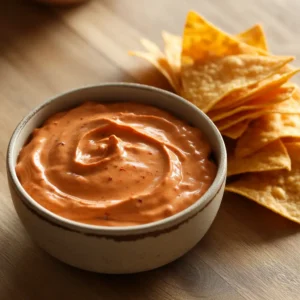
Mexican Hot Sauce Recipe (Salsa Roja, Taquería-Style)
Equipment
- Blender or high-speed blender
- Sheet pan or saucepan (for roasting or boiling)
- Dry skillet for toasting chiles
- Tongs and slotted spoon
- Funnel
- Squeeze bottles or jars with lids
- Optional: pH meter if canning
Ingredients
For Salsa Roja (about 2 cups)
- 4 medium ripe tomatoes cored (about 650 g)
- 3 –6 dried chiles de árbol stems removed (hot). Sub: 1–2 serrano chiles or 1 large jalapeño for milder heat
- 1/4 medium white onion roughly chopped (about 40 g). Sub: yellow onion
- 2 garlic cloves peeled (about 8 g)
- 1/4 cup white vinegar or 3 tbsp fresh lime juice. Sub: apple cider vinegar
- 1/4 cup cilantro leaves lightly packed (about 10 g). Sub: parsley for a different profile
- 1/2 tsp fine sea salt plus more to taste
- 1/4 –1/2 cup water as needed to thin
Optional Flavor Boosters
- 1/4 tsp Mexican oregano or a pinch of ground cumin
- 1 tsp sugar or a splash of orange juice if bitterness occurs
- 1 chipotle in adobo for smoky heat
- 1 ripe avocado for a creamy guacamole-style version
Instructions
Toast the dried chiles
- Heat a dry skillet over medium. Toast chiles de árbol 30–60 seconds, turning until fragrant and a shade darker. Do not burn. If using fresh serrano or jalapeño, skip to step 2.
Soften dried chiles (if used)
- Cover toasted chiles with hot water for 10 minutes, then drain well.
Cook the vegetables: roast or boil
- Roast method: place tomatoes, onion, and garlic on a sheet pan under a hot broiler until blistered in spots, 6–10 minutes, turning once.
- Boil method: simmer tomatoes, onion, and garlic in a saucepan until just tender, 6–8 minutes; drain well.
Blend until silky
- Add cooked tomatoes, onion, garlic, softened chiles (or fresh chiles), vinegar or lime, cilantro, salt, and 1/4 cup water to a blender. Blend on high until perfectly smooth. Add more water in small splashes until the sauce pours easily from a squeeze bottle.
Taste and balance
- Adjust salt and acidity. If flavor seems flat, add a little more vinegar or lime. If it tastes bitter from over-toasted chiles, blend in 1 tsp sugar or a small splash of orange juice.
Optional set and sheen
- For a slightly glossier finish, simmer the blended sauce in a small pan for 5 minutes, then cool.
Bottle and chill
- Funnel the sauce into clean jars or squeeze bottles. Refrigerate at least 1 hour to let flavors meld. Shake before serving.
Pro tips
- Thin and glossy is the restaurant texture. Add water or vinegar a tablespoon at a time until pourable.
- Heat ladder: jalapeño (mild), serrano (medium), árbol (hot). Mix to your level.
- For tacos, keep the sauce thin so it coats evenly without soaking tortillas.
Notes
Nutrition Information
Estimated per 2 tbsp (30 g) serving:SERVING: 30 g | CALORIES: 12 kcal | CARBOHYDRATES: 2.6 g | PROTEIN: 0.4 g | FAT: 0.1 g | SATURATED FAT: 0.0 g | CHOLESTEROL: 0 mg | SODIUM: 118 mg | POTASSIUM: 123 mg | FIBER: 0.6 g | SUGAR: 1.6 g | VITAMIN A: 420 IU | VITAMIN C: 8 mg | CALCIUM: 10 mg | IRON: 0.3 mg (Nutrition is an estimate and will vary with exact ingredients and thickness.)
Price of Recipe
- Total estimated cost: $4.00 for ~16 servings (about $0.25 per serving)
- Breakdown:
Tomatoes $1.50 • Dried chiles $0.60 • Onion/garlic $0.40 • Cilantro $0.50 • Vinegar/lime $0.70 • Salt/seasonings $0.30
Recipe Notes
- Substitutions:
Vinegar ↔ lime; chile de árbol ↔ serrano/jalapeño; cilantro ↔ parsley. Use canned fire-roasted tomatoes when fresh are out of season. - Heat control:
Remove seeds and membranes for milder heat. Keep a few for extra kick. Combine chiles for a layered flavor. - Texture:
If too thin, simmer 5–10 minutes to reduce. If too thick, add water or vinegar 1 tbsp at a time. - Storage:
Refrigerate in airtight bottles 5–7 days. Freeze in small jars or ice cube trays up to 2 months. Whisk to re-emulsify after thawing. - Canning note:
For shelf-stable canning you need pH ≤ 3.5 and an approved process. If you are not measuring pH, refrigerate or freeze. Do not can versions with oil or dairy. - Diet: Vegan, Gluten-Free, Dairy-Free
Call-to-Action
Did you try this Mexican hot sauce recipe? Rate it, leave a comment with your heat level and favorite taco pairing, and share a photo so others can see your version.
Mexican Green Hot Sauce Recipe (Salsa Verde, Taquería-Style)
Equipment
- Blender or food processor
- Sheet pan or saucepan
- Tongs or slotted spoon
- Funnel
- Squeeze bottles or jars with lids
Ingredients
For Salsa Verde (about 2 cups)
- 1 lb tomatillos husked and rinsed (about 450 g)
- 2 –4 serrano peppers stems removed (use jalapeños for a milder sauce)
- 1/4 medium white onion roughly chopped (about 40 g)
- 2 garlic cloves peeled (about 8 g)
- 3 tbsp fresh lime juice. Sub: white vinegar for sharper acidity
- 1/4 cup cilantro leaves about 10 g. Sub: parsley for a lighter flavor
- 1/2 tsp fine sea salt plus more to taste
- 1/4 –1/2 cup water as needed to thin
Optional Flavor Variations
- 2 –3 tbsp Mexican crema or sour cream for a creamy verde
- 1 ripe avocado for a smooth guacamole-style salsa
- 1 roasted poblano for added smokiness
Instructions
Cook the vegetables: roast or boil
- Roast method: place tomatillos, serranos, onion, and garlic on a sheet pan under the broiler until blackened in spots, 6–10 minutes.
- Boil method: simmer ingredients in water until just tender, 5–7 minutes; drain well.
Blend until smooth
- Add cooked tomatillos, peppers, onion, garlic, lime juice, cilantro, salt, and 1/4 cup water to a blender. Blend until completely smooth.
Adjust thickness
- Add extra water or lime juice a tablespoon at a time until the sauce reaches a thin, pourable texture.
Taste and refine
- Adjust salt and acidity. For creamy verde, blend in crema or avocado.
Bottle and chill
- Funnel into jars or squeeze bottles. Refrigerate at least 1 hour before serving to allow flavors to settle.
Pro Tips
- For a spicier verde, leave in the serrano seeds and membranes.
- For smoky flavor, roast the tomatillos and chiles over a gas flame or grill instead of boiling.
- Always thin enough so the sauce drizzles, not clumps — the true taquería style.
Notes
Nutrition Information
Estimated per 2 tbsp (30 g) serving:SERVING: 30 g | CALORIES: 10 kcal | CARBOHYDRATES: 2.2 g | PROTEIN: 0.4 g | FAT: 0.1 g | SATURATED FAT: 0.0 g | CHOLESTEROL: 0 mg | SODIUM: 116 mg | POTASSIUM: 128 mg | FIBER: 0.7 g | SUGAR: 1.3 g | VITAMIN A: 270 IU | VITAMIN C: 7 mg | CALCIUM: 8 mg | IRON: 0.2 mg (Nutrition values vary with pepper quantity and thickness.)
Price of Recipe
- Total estimated cost: $3.50 for ~16 servings (about $0.22 per serving)
- Breakdown:
Tomatillos $1.50 • Serrano peppers $0.80 • Onion/garlic $0.40 • Cilantro $0.50 • Lime $0.30
Recipe Notes
- Substitutions: jalapeños for milder sauce; vinegar instead of lime; parsley instead of cilantro.
- Storage: refrigerate 5–7 days in sealed bottles, or freeze in ice cube trays up to 2 months.
- Variations: creamy verde with crema; guacamole salsa with avocado; poblano for smokiness.
- Canning tip: safe only if pH ≤ 3.5. If unsure, refrigerate or freeze instead.
- Diet: Vegan, Gluten-Free, Dairy-Free (unless using crema variation)
Call-to-Action
Did you enjoy this tangy Mexican green hot sauce recipe? Leave a rating, drop a comment with your favorite way to use it, and share this salsa verde with friends who love tacos!Small-Batch Fermented Mexican Hot Sauce
If you want to experiment with natural tang and probiotics, you can make a fermented Mexican hot sauce recipe. This method is not traditional in every region, but it adds depth and complexity.
2–5 Day Ferment Basics
- Prepare a brine: Use a ratio of about 3–4% salt to water (30–40 g of salt per liter of water). Stir until dissolved.
- Chop and submerge: Roughly chop chiles, garlic, and onion. Place in a clean jar and cover completely with the salt brine. Use a fermentation weight or small clean jar inside to keep everything submerged.
- Ferment at room temperature: Leave the jar at room temp (65–75°F / 18–24°C) for 2–5 days. You should see bubbles forming—this is natural lactic fermentation.
- Blend and stabilize: After fermenting, drain (but reserve) some brine, then blend the softened chiles and aromatics with vinegar and salt to taste. Vinegar not only balances the flavor but also helps stabilize the sauce for refrigeration.
- Store: Keep refrigerated in bottles or jars. Flavors will continue to develop slowly over time.
Note: Always use clean utensils and jars. If mold develops on the surface (not just harmless white yeast), discard the batch.
Spicy Mexican Sauce Names (Quick Glossary)
To round out your knowledge (and catch search queries like spicy mexican sauce names), here are some of the most common sauces you’ll see in Mexico and in taco shops:
- Salsa roja: The classic red hot sauce with tomato and árbol or serrano chiles.
- Salsa verde: Tomatillo-based green hot sauce, tangy and bright.
- Salsa taquera: A thin, árbol chile sauce poured from squeeze bottles in taco stands.
- Salsa habanera: Extremely hot, fruity, and vibrant orange in color.
- Salsa de guacamole (avocado hot sauce): Smooth, creamy, and mild.
- Salsa ranchera: Tomato-chile sauce, sometimes cooked with oil and served warm.
- Salsa macha: Oil-based sauce with dried chiles, nuts, and seeds (not suitable for water-bath canning).
- Pico de gallo: Chunky fresh salsa, delicious, but not considered hot sauce.
Conclusion
Making your own authentic Mexican hot sauce recipe at home is simpler than it looks. With just a handful of ingredients, tomatoes or tomatillos, chiles, onion, garlic, cilantro, and vinegar or lime, you can create restaurant-style roja and verde sauces that rival anything from a taco stand.
This guide covered both red and green bases, roasting vs boiling, variations with avocado, orange, or habanero, plus storage and safe canning tips. Whether you want a mexican hot sauce recipe for tacos, breakfast dishes, or marinades, these sauces will bring the tangy, spicy flavor that makes Mexican food unforgettable.
Now that you know the techniques and variations, experiment with your own heat levels and flavor twists. With a little practice, you’ll have a signature house hot sauce, one that takes your tacos, burritos, bowls, and eggs to the next level.
Did you try this Mexican hot sauce recipe?
Share your thoughts in the comments below, was it salsa roja, salsa verde, or a creative twist like avocado, orange, or mango that won your heart? Don’t forget to rate the recipe, pin it for later on Pinterest, and tag us if you drizzle it over your next taco night!




